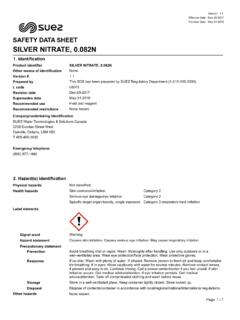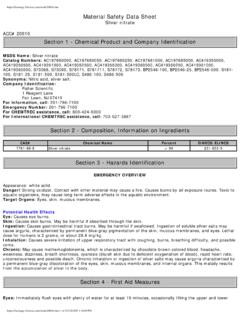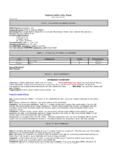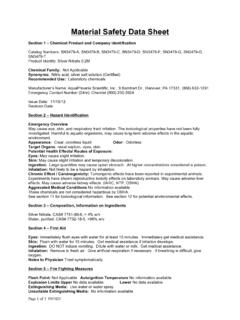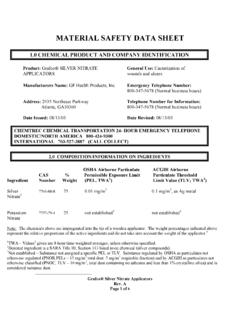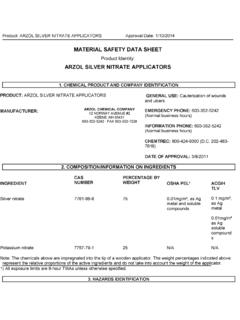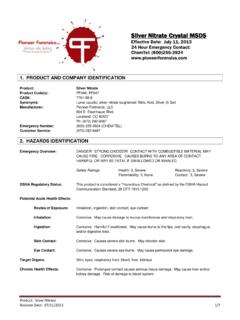Transcription of Safety Data Sheet: AgNO3 - Modison
1 Safety data sheet : AgNO3 1. Product and Company Identification Trade Name: silver nitrate Chemical Formula: AgNO3 Recommended Use: Commercial Manufacturer/Supplier: Modison Metals Ltd, Vapi, India 396195 Tel #: +91 260 2431093 _____ 2. Hazards Identification Hazard Classification: Hazardous according to criteria of Hazardous Substances Information System [HSIS Worksafe Australia]. Hazardous and/or Dangerous Nature: HAZARDOUS SUBSTANCE. Risk Phrases: R8: Contact with combustible material may cause fire. R34: Causes burns. R50: Very toxic to aquatic organisms.
2 R53: May cause long term adverse effects in the aquatic environment. Safety Phrases: S26: In case of contact with eyes, rinse immediately with plenty of water and seek medical advice. S36/37/39: Wear suitable protective clothing, gloves and eye/face protection. S45: In case of accident or if you feel unwell seek medical advice immediately. S60: This material and its container must be disposed of as hazardous waste. S61: Avoid release to the environment. Refer to special instructions/ Safety data sheet . 3. Composition Chemical Family: silver salt Additional Names: Lunar Caustic silver (Ag): % AgNO3 (%) : >99% CAS #: 7761-88-8 EC #: 231-131-3 _____ 4.
3 First Aid Procedures General Treatment: Seek medical attention if symptoms persist. Special Treatment: None Important Symptoms: None Inhalation: Remove victim to fresh air. Supply oxygen if breathing is difficult. Ingestion: Rinse mouth thoroughly. Give one to two glasses of water. Do not induce vomiting if swallowed. Never i give anything by mouth to an unconscious person. Skin:Wash affected area thoroughly with plenty of running water. Remove contaminated clothing and wash before reuse. If symptoms develop seek medical attention. Eyes: Flush eyes with water, blinking often for ten minutes.
4 5. Fire and Explosion Hazards data Flammability: Non-flammable Flash Point: N/A Autoignition Temperature: N/A Extinguishing Media: Do not use water for metal fires. Use special powder, sand, CO2 Spec. Fire Fighting Procedure: Use full-face, self-contained breathing apparatus with full protective clothing to prevent contact with skin and eyes. 6. Accidental Release Measures If Material Is Released/Spilled: Wear appropriate respiratory and protective equipment specified in special protection information. Isolate spill area and provide ventilation.
5 Vacuum up spill using a high efficiency particulate absolute (HEPA) air filter and place in a closed container for disposal. Take care not to raise dust. Environmental Precautions: Isolate runoff to prevent environmental pollution. 7. Handling and Storage Handling Conditions: Wash thoroughly after handling. Storage Conditions: Store in a cool dry place in a tightly sealed container. Work/Hygienic Maintenance: Do not use tobacco or food in work area. Wash thoroughly before eating and smoking. Do not blow dust off clothing or skin with compressed air.
6 Ventilation: Provide sufficient ventilation to maintain concentration at or below TLV. 8. Exposure Controls and Personal Protection Permissible Exposure Limits: mg/m3 Threshold Limit Value: mg/m3 Special Equipment: None Respiratory Protection: Should comply with AS1716 and be selected in accordance with AS1715. In event of emergency a full-face piece SCBA should be used Protective Gloves: Should comply with AS2161. Excellent gloves made from NR Latex, vinyl or neoprene. Good glove made from Nitrile can also be used Eye Protection: Face shield, chemical goggles or Safety glasses with side shields.
7 Body Protection: Protective work clothing. Wear close-toed shoes and long sleeves/pants. 9. Physical and Chemical Characteristics Color: White solid Form: Crystals/powder Odor: Odorless Solubility: Readily soluble in ammonia water. Soluble in glycerol, diethyl ether and hot alcohol. Very soluble in acetone pH: Decomposition temperature: ~444C Taste: Bitter, caustic metallic taste Melting Point: ~212 C Density: ~ g/cc Molecular weight: 10. Reactivity Stability: Stable under recommended storage conditions Reacts With: Reacts with acetylene in presence of ammonia to form silver acetylide, a sensitive powerful detonator when dry.
8 In the absence of ammonia, or when calcium actylide is added to a silver nitrate solution, explosive double salts of silver acetylide and silver nitrate are produced. Mercurous acetylide precipitates silver acetylide from aqueous nitrate . Reaction with chlorosulfonic acid is violent with nitrosulfonic acid being formed. Reduced by hydrogen sulfide in the dark. Easily reduced to metallic silver by ferrous salts, arsenates, hypophosphites, tartrates, sugars, tannins, volatile oils. Dry powdered magnesium and silver nitrate may ignite explosively on contact with a drop of water.
9 Reaction with ammonium hydroxide, sodium hydroxide and stirring may be explosive. Reaction with phosphorus, or sulfur, and shock may be violently explosive. Reaction with charcoal and shock may result in ignition. Highly sensitive explosive is formed when calcium carbide is added to silver nitrate solution. Reaction with alcohols may form and explosive fulminate. Incompatible Conditions: Reducing agents, combustible materials, organic materials, easily oxidised materials, acetylene + ammonia, acetylidene, alcohols, aldehydes, alkalis, alkali hydroxides, ammonia, ammonium compounds, antimony salts, arenites, benzalkonium chloride, bromides, carbonates, carbides, charcoal, chlorides, chlorosulfonic acid, creosote, ferrous salts, halogenated acids and their salts, hydrazine and derivatives, hydrogen peroxide, hydrogen sulfide, hypophosphites, iodides, magnesium in powdered form (with water)
10 , morphine salts, nitriles, nonmetals, oils, organic nitro compounds, phosphates, sodium hydroxide, sugars, tannic acid, tannins, tartrates, thimerosal, thiocyanates,vegetable decoctions, and extracts, volatile oils. Haz. Decomposition Products: Oxygen, toxic fumes, nitrous gases, toxic oxides of nitrogen, silver / silver oxides.. 11. Toxicological Information Potential Health Effects: Eyes: Causes irritation Skin: May cause allergic reaction Ingestion: Harmful if swalloed Inhalation: May cause irritation Chronic: NA Signs & Symptoms of Exposure: N/A Medical Conditions Aggravated by Exposure: N/A Median Lethal Dose: N/A 12.
